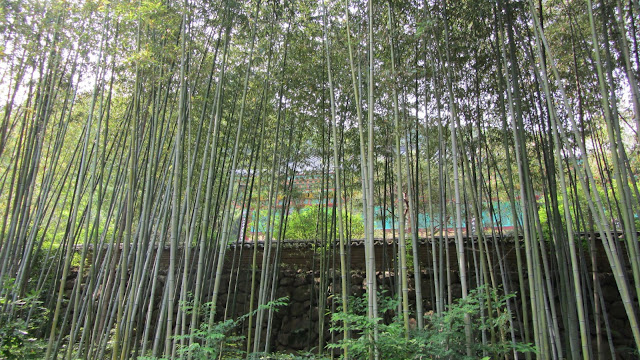Last weekend, we went on a tour with the Gwangju International Center (GIC). They do one tour a month to various places in Korea, and we have gone with them several times. This month, we went to Jirisan National Park, the first national park in Korea, home of the tallest mountain in Korea (excluding the one on Jeju Island).
 |
| Entry to the Rehabilitation Center |
We were excited for this trip because we would be stopping at the Jirisan Moonbear Rehabilitation Center. Moon Bears are native to South Korea, but due to some poaching practices had become almost extinct. They are called Moon Bears because of the half-moon shape on their chest. In the last 10 years, there has been a major effort to rehabilitate the species and Jirisan park was chosen as the place to revive the species. When we arrived at the center, we were taken on a tour to see some of the bears that were currently living in enclosures. One pair, a mother and daughter, had been brought from Russia to Korea. The bears from Russia are genetically identical, and so are brought to help bring up the population in Korea. They remain in large enclosures for 5 years so they can completely transition to Korea's weather and food before being let out into the wild. It was nice to see them up close.
 |
| You can really see the moon shape here |
Another enclosure held 2 other bears, but these would never be released into the wild. They had been brought to the center as cubs. One had been injured by poachers traps, and the other had been fed so much human food that half of it's teeth fell out, leaving it unable to successfully forage.
After seeing the bears, we watched a brief documentary about the process of bringing them from Russia to Korea. In the 10 years since the program has been in effect, the bear population has risen by about 30 bears, so it has been a success.
After visiting the bears, we had a delicious lunch of dolsot bimbimbap (rice cooked in a hot stone with various beans) and shitake mushroom pancake (forget how to say it in Korean!) It was a yummy meal.
 |
| On our way to lunch, we drove past a poppy field and stopped for pictures |
 |
| And of course, it isn't a Korean meal without lots of various side dishes |
The foothills of Jirisan are well known for the quality green tea produced in the area. This area has some of the oldest cultivated green tea fields in Korea. So, we got to learn how to pick green tea leaves, and then were brought to a community center where we were able to dry and prepare the green tea for drinking. Afterwards, we tried the tea and got to take some home with us. Refreshing!
 |
| The Tea Field |
 |
| The woman who taught us how to pick the leaves and prepare them for drinking |
 |
| Bradley, Boram, and Hyein |
 |
| Our leaves picked and ready to be prepared |
 |
| First, you put on gloves |
 |
| Then you put the leaves in hot cauldron and dry them, they make a cracking sound like rice krispies cereal and the leaves get sticky |
 |
| Second step, dump the leaves out on a rough mat and grind them together to release all the good stuff from inside the leaves |
 |
| Bradley's turn |
 |
| After being rubbed, the leaves are left out to dry and then can be used in tea |
Our last stop was to Ssanggye Temple at the foot of Jirisan. This temple was beautiful, set among the trees near a creek. It holds some of the oldest Buddhist wood-block carvings in Korea, used for hundreds of years to print Buddhist scriptures, as well as various paintings and religious items used in ceremonies. It was a lovely, spiritual place.
 |
| Guardians to the temple |
We had a great time on this tour and we are looking forward to the next.


















































